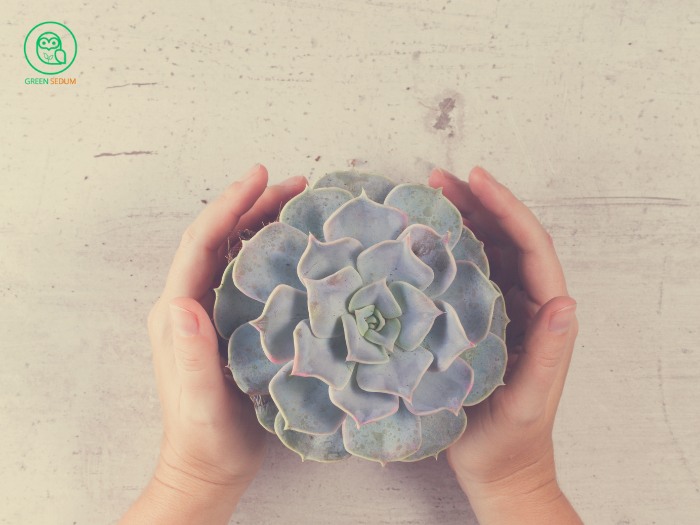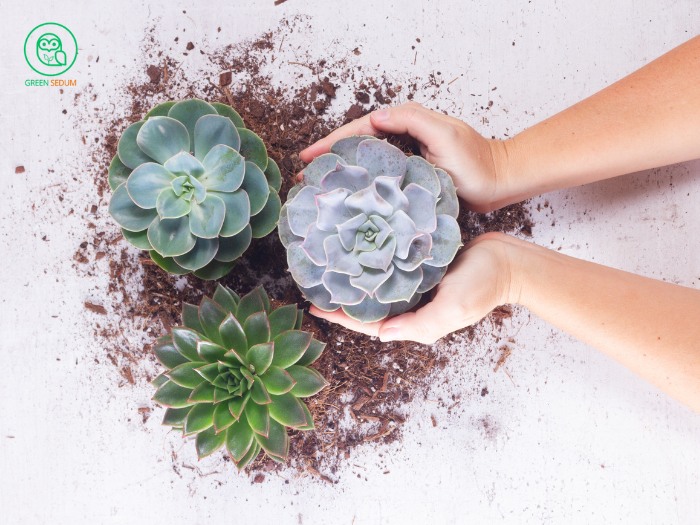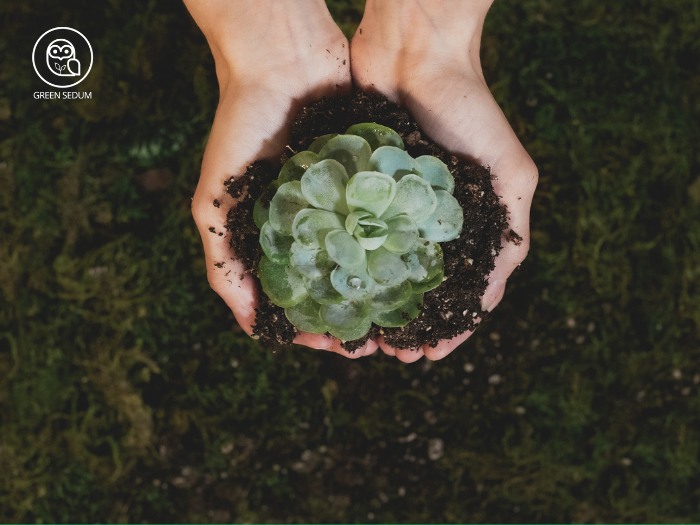New succulent enthusiasts often dream of creating their own mini succulent garden. However, before diving in, it’s essential to learn how to care for succulents properly to ensure your plants stay healthy and to understand these unique plants better.
This article, shared by a dedicated succulent expert, provides valuable insights and tips on how to care for succulents. With this knowledge, you can create a beautiful, dream-like mini garden without breaking the bank.
>>> See more articles on this topic:
- What is a Succulent? A Comprehensive Guide for Plant Lovers
- Best Practices to Plant Succulents Indoors and Outdoors
1. The Joy of Caring for Succulents
Learning how to care for succulents is not just an enjoyable hobby, but it also brings many unexpected benefits. Firstly, it helps you understand these unique plants better. Initially, you might face challenges and even lose a few plants, but over time, you’ll learn the best ways to care for them.
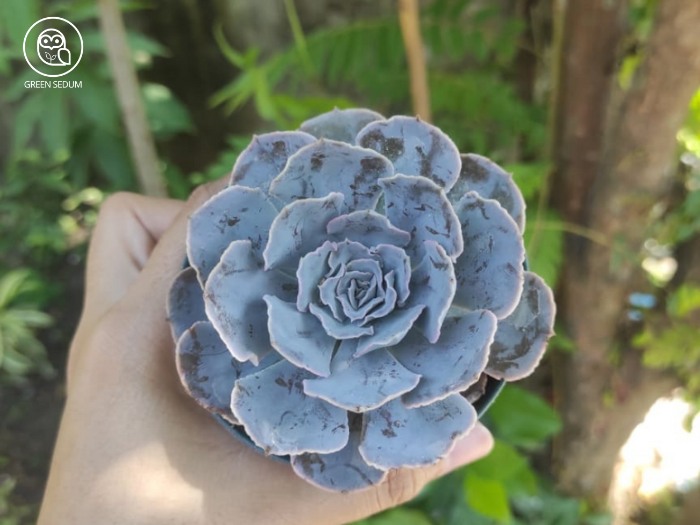
The process of caring for succulents also sharpens your observational skills, attention to detail, and patience. You’ll become more attuned to the small things that ensure your plants stay healthy.
Additionally, tending to succulents is a fantastic way to relax and stabilize your emotions after a long day at work. For example, after spending 8 hours at the office, I often feel exhausted. However, thinking about my succulents, I grab a watering can and tend to each pot. Sitting back and admiring them helps melt away my stress, leaving me with a sense of peace and tranquility.
2. How to Care for Succulents When You First Bring Them Home
Continuing from our post on growing succulents in full sun and rain, Green Sedum offers detailed guidance on caring for succulents from the moment you bring them home until it’s time to repot. In this section, we’ll focus on choosing the right pot, watering tips, soil mix, and lighting needs.
2.1. Choosing the Right Pot
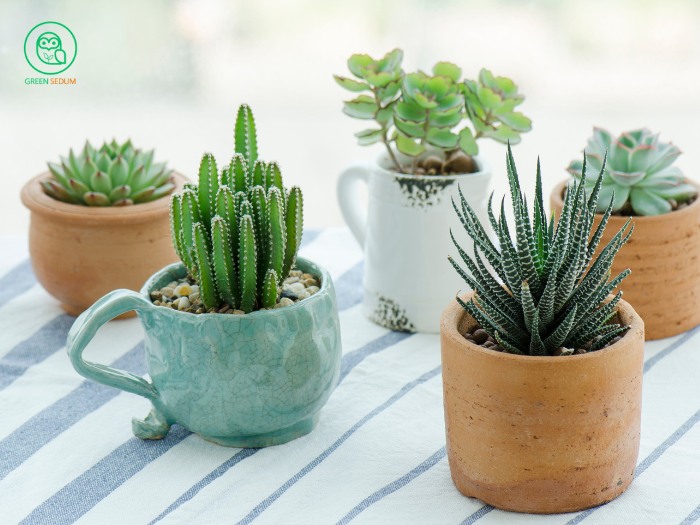
Selecting the right pot is crucial for the healthy growth and long-term care of your succulents.
When it comes to pots…
There are a wide variety of succulent pots available on the market, ranging from mini to medium and large sizes. These come in different materials like wood, terracotta, cement, stone, ceramic, metal, and plastic. You can choose a pot based on your personal preference and style.
However, for those new to growing succulents, I recommend starting with terracotta pots. For experienced succulent enthusiasts looking to experiment with different styles, feel free to explore other options.
Succulents don’t like excess moisture and hate being waterlogged. Terracotta pots have several advantages that make them ideal for succulents:
- Good Drainage: Terracotta pots allow water to evaporate through the porous surface, preventing water from pooling and reducing the risk of root rot.
- Breathability: The breathable nature of terracotta keeps the roots cool, even on hot days.
- Perfect Drainage Hole: These pots typically have well-sized drainage holes.
- Simple, Artistic Appearance: The rustic and earthy look of terracotta pots adds a high level of aesthetic appeal.
- Affordable: Terracotta pots are also very budget-friendly.
2.2. Care Tips for Succulents: Focus on the Growing Medium
For those new to how to care for succulents, it’s best to avoid using garden soil. Instead, opt for specialized growing mediums from reputable brands like Espoma Organic Cactus or Gardener Coffee Mug. These can be found at agricultural supply stores and online marketplaces.
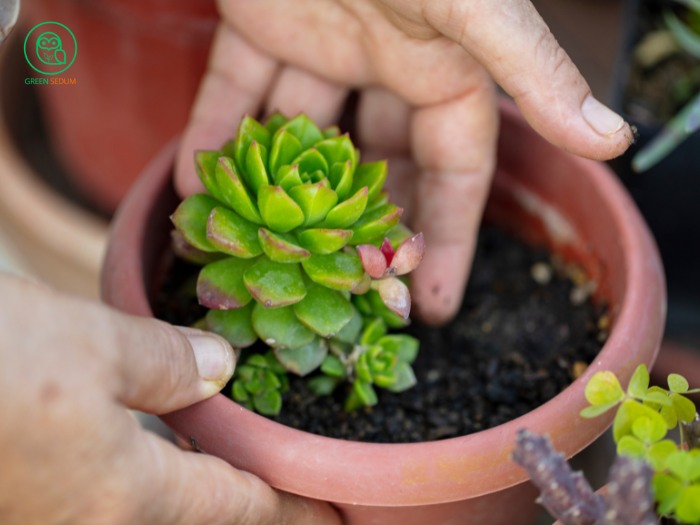
Alternatively, you can create your own mix as long as it meets key requirements: good aeration, light texture, and adequate nutrients. A clean, well-draining growing medium is essential for succulents. Keep this in mind to ensure your mini garden thrives when it’s time to change the medium.
For instance, at Green Sedum, we always mix new growing mediums with perlite and pumice to make them more suitable for full sun and rain exposure. Our typical mix includes a small amount of goat manure, rice husks, lots of perlite, pottery clay tablets, pumice, coconut coir, and a bit of beneficial microbial fungi.
We line the bottom of the pot with pottery clay tablets before adding the mixed medium, and then top it off with pumice or small clay pellets.
2.3. Light and Placement Tips for Succulents
Understanding how to care for succulents involves recognizing their love for sunlight. While some succulents are sun-loving and others are shade-tolerant, they all benefit from proper lighting. Popular types recommended for beginners by Green Sedum thrive under the “Sunshine of Your Love.”
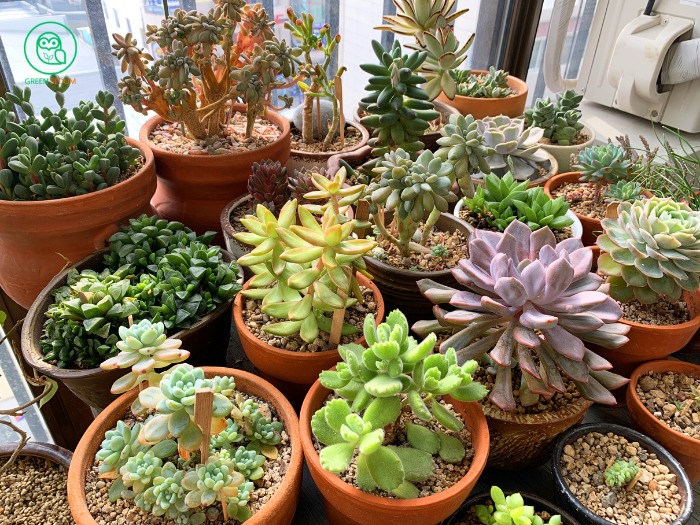
Selecting the right location for your succulents is crucial. Ideally, place them outdoors on a terrace, balcony, or garden—areas with plenty of sun and wind. Aim for at least 4 hours of sunlight daily. If the sunlight is too intense, consider using garden netting for some shade.
If you lack optimal outdoor space, try growing dragon claw succulents near the sunniest window in your home.
Tips for Sun Exposure for Newly Planted Succulents:
For newly bought and potted succulents, follow these steps to acclimate them to sunlight:
- Initial Shading: Keep them in a shaded, cool area for about 14 days.
- Morning Sunlight: After this period, move them to a spot with gentle morning sunlight (7:30 AM to 10 AM) for two weeks.
- Full Sun Exposure: Finally, transition them to a spot with full sun exposure.
This gradual acclimatization helps succulents adjust to the hot climate, ensuring stable and long-term growth without shock.
Recommended Sunlight Conditions for Different Succulents:
- Sun-loving succulents: Graptosedum Bronze Variegata, Sedum adolphi ‘Firestorm’, Kalanchoe tomentosa ‘Chocolate Soldier’, Crassula Capitella, Black Prince.
- Succulents preferring light sun: Jelly Beans, sugar almond plant, Sempervivum Calcareum, Sedum morganianum.
2.4. Watering Succulents Properly
Succulents are plants that store water in their leaves, stems, and roots, so they do not need frequent watering. However, knowing how to care for succulents correctly is crucial.
Ah-ha! One more thing… Don’t be fooled by those TikTok videos showing people dunking succulents in water or spraying them forcefully from above. Such methods are not suitable for newly purchased succulents. First, those videos are often created for entertainment. Second, nurseries have many succulents to care for, so watering each pot individually is time-consuming, and their plants are usually very resilient.
So, for beginners, watch those videos for fun but don’t follow them just yet. If your plant dies suddenly, you’ll be crying, haha.
Once your succulents have acclimated to your local climate and you have a collection, you can consider more robust watering methods.
Here are some watering tips from Green Sedum:
Water Amount: Different succulents have varying water needs. Some require more water, while others need less. Water evenly around the pot and ensure water drains out of the bottom.
When to Water: Check the weather conditions first. Has it been rainy and cloudy or hot and sunny? Only water when the soil is completely dry. You can use your finger to check the soil moisture.
Best Time to Water: Water your succulents early in the morning (6 AM – 7:30 AM) or in the late afternoon (around 5 PM). Avoid watering during peak sunlight hours (9 AM – 2 PM) to prevent heating the pot and don’t water at night.
Avoid Watering from Above: To help your succulent absorb water efficiently, water at the base of the plant, not on the leaves. Water on the leaves can cause them to stay wet for too long, creating a humid environment that attracts harmful bacteria and insects.
Watering Tools: Use a dedicated watering can for succulents or a misting spray bottle. Green Sedum likes to reuse old teapots for watering, haha.
Here’s a quick guide to succulents that prefer more or less water:
- Less Watering: These succulents usually have low-growing forms and plump leaves. Most are rosette-forming plants with water-storing leaves (except for a few tall varieties like Echeveria ‘Crinoline Ruffles’).
- Moderate Watering: Tall succulents that are less prone to rotting, such as Hobbit Jade, Echeveria amoena f. cristata, Zebra Cactus, and Haworthia mirabilis var. mirabilis, prefer a moderate amount of water.
- More Watering: Succulents with thinner leaves need more water. Examples include Orostachys boehmeri, long-lived Zebra Cactus, Jelly Bean Plant, Sedum, Elephant Bush, and Crassula capitella ‘Campfire’.
>>> Explore similar topic: How Often to Water Succulents: Avoid Overwatering with These Expert Tips
3. How to Care for Succulents: Tips for Healthy Growth
To successfully grow succulents in full sun and rain in hot climates, patience and observation are key. After 1-2 months, once your newly purchased succulents have adapted to their new environment, continue to monitor and care for them to ensure their health.
3.1. Maintaining Watering Levels
Understanding how to care for succulents includes mastering your watering routine. After watering each succulent pot for a while, you’ll start to notice which pots drain faster and which locations aid drainage. Adjust your watering schedule accordingly.
For example, at Green Sedum in California, we grow and care for succulents on a west-facing balcony exposed to full sun and rain. Our plants receive some morning sun but endure harsh midday and afternoon sun. Therefore, we water them twice a week (Tuesdays and Saturdays).
3.2. Weekly Observation
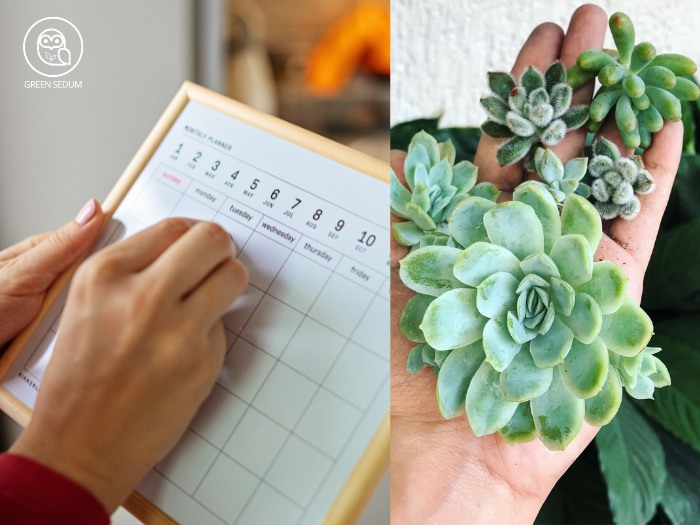
Regular observation is crucial for succulent care. This practice helps you understand the current condition of your plants and catch any issues early. Here’s what to look for:
- Is the soil too moist? Are the pots draining well?
- Are there any pests like millipedes, mealybugs, or red spider mites?
- Are there any wrinkled or dried leaves that need to be removed?
- Are there small roots growing from the nodes? This indicates potential issues at the base.
- How are the flowers blooming? They can be quite beautiful!
This weekly check-in not only helps you maintain your succulents’ health but also allows you to enjoy their beauty as they thrive.
3.3. Caring for Mini Succulents in the Sunny Season
This is my favorite season because the succulents start showing vibrant colors. However, I’m cautious about sunburned leaves. I’ll water them a bit more than usual and rotate the pots to ensure even sunlight exposure on both sides. This prevents the plants from leaning to one side, maintaining their aesthetic appeal.
3.4. Preparing for the Rainy Season
During the rainy season, it’s essential to prepare mentally and maybe even recite a few prayers, hehe. It’s a season that claims the pots of many succulent enthusiasts.
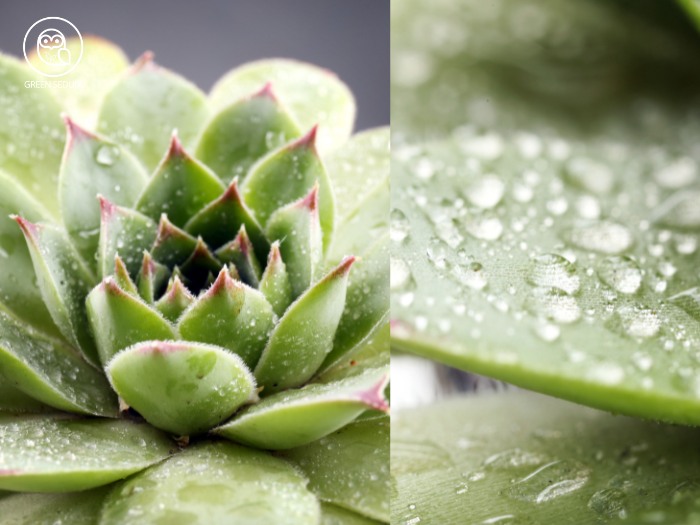
The gloomy weather and lack of sun can dull the colors of the plants, making them less attractive. Moreover, the high humidity and excessive rain can lead to fungal diseases, root rot, and stem rot.
BUT, don’t worry if you’ve been growing and caring for your succulents properly with organic methods. Healthy plants are resilient and less prone to death. If any plant shows signs of weakness, it was likely weak to begin with, making it susceptible to perishing. If you discover stem rot too late, salvage the leaves for propagation and discard the rest.
During the rainy season, monitor the weather and reduce watering frequency. Identify pots that tend to stay damp and isolate them, replacing the entire medium to ensure the plants’ health.
3.5. When to Fertilize
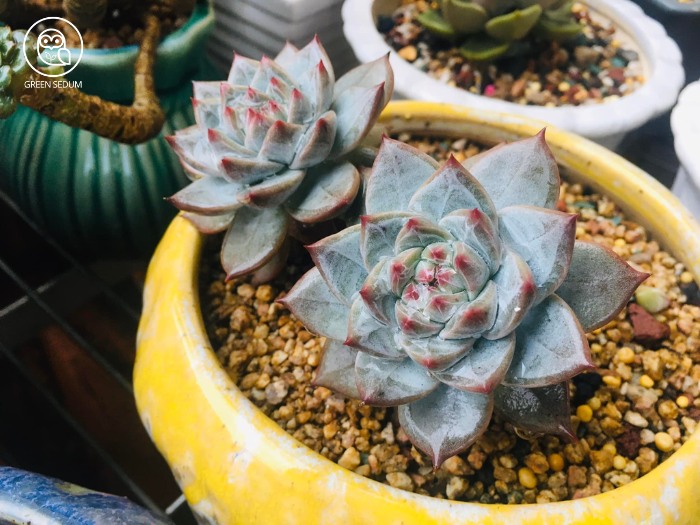
Succulents naturally require minimal nutrients, so when caring for them, it’s best to limit fertilizer application.
For me, I fertilize only once every 5 to 6 months, using a very low dosage. I prefer organic fertilizers, such as composted manure, worm castings, crushed eggshells, or kitchen compost, which have been processed and aged. Lately, I’ve been using slow-release worm castings pellets.
At Green Sedum, we prioritize natural methods to avoid any chemical sensitivities, especially since we have elderly and young family members. Remember to thoroughly process organic fertilizers before use.
Note: Ensure that all organic fertilizers are thoroughly sanitized before application.
3.6. When to Repot? Should You Trim the Roots?
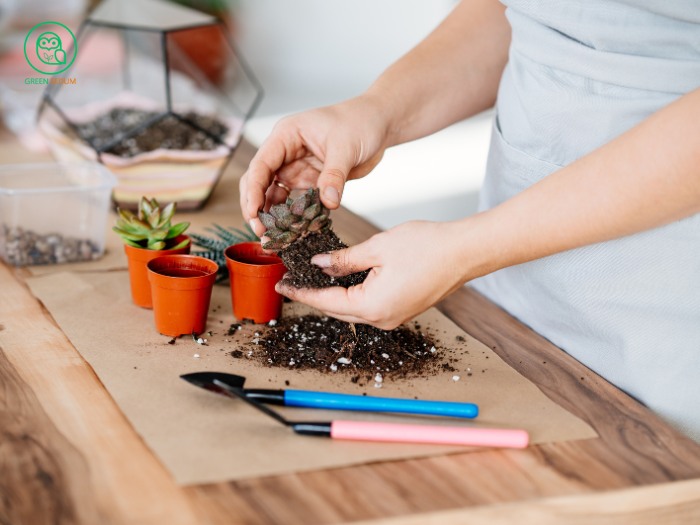
After a prolonged period of nurturing succulents under full sunlight and rain, the soil in their pots becomes compacted, devoid of nutrients, and less permeable due to clogged drainage holes.
Signs to watch for include:
- Leaves becoming shorter and more vibrant in color.
- While watering, leaves remain wrinkled and soft, indicating poor water absorption:
- The root system may be damaged.
- The plant may not produce new roots.
- Overgrowth of roots may hinder new root development.
Hence, smaller pots should be replaced every 6 months, while larger ones can be refreshed annually or as needed.
Repotting Process:
- Upturn the Pot: Carefully remove the plant from its current pot.
- Trim Dead Parts: Eliminate dried leaves and withered stems.
- Root Maintenance: Trim only old and excessively long roots; avoid radical root pruning.
- Repotting: Plant in a new pot with fresh soil mix.
Important:
- Avoid watering immediately to prevent infection. Wait 3-5 days before watering.
- Keep the plant in shade for about a week before exposing it to light.
- Retain the old soil mix for other plants by sun-drying and mixing with organic compost and beneficial fungi.
4. Common Issues with Succulents
4.1. “Overindulging in Succulent Care”
Common among beginners is the tendency to excessively pamper succulents, constantly inspecting each leaf, touching them, or relocating pots frequently, out of an overprotective instinct.
BUT WAIT, THERE’S MORE!
Succulents, by nature, thrive in sunlight and breeze, embracing a carefree lifestyle. They withstand harsh weather conditions without a fuss.
Hence, limit the urge to overindulge in care. Treat them with a laissez-faire attitude, just observe! Similar to a child raised in a sheltered urban environment, devoid of exposure to the sun or rain, lacking physical activity, they may grow up frail. Unlike children from rural areas, accustomed to frolicking in fields, enjoying rain showers and sunshine, engaging in strenuous labor, leading to robust health. Reflect on your childhood memories…
4.2. Signs of Yellowing Leaves
Symptoms: Yellow and wilted leaves.
Causes:
Typically, this occurs due to heat shock. Most succulents are transported from temperate climates to hotter regions, leading to sudden climate changes. Additionally, the heat-absorbing properties of the potting medium can exacerbate the issue in dry conditions. Other factors include water or nutrient deficiency.
Remedies:
- Firstly, remove the yellow leaves and relocate the plant to a cooler spot. Mist the plant to increase humidity and continue monitoring for the next 3-4 days for any further yellowing.
- If yellowing persists, indicating wilted and wrinkled leaves, it’s best to lift the plant, trim the roots and stem, then allow it to dry in a cool place. Once the plant develops new roots, replant it using fresh potting medium.
- If the issue extends to the stem, it may be challenging to salvage, and purchasing a new plant is advisable.
4.3. Sunburn on Succulents
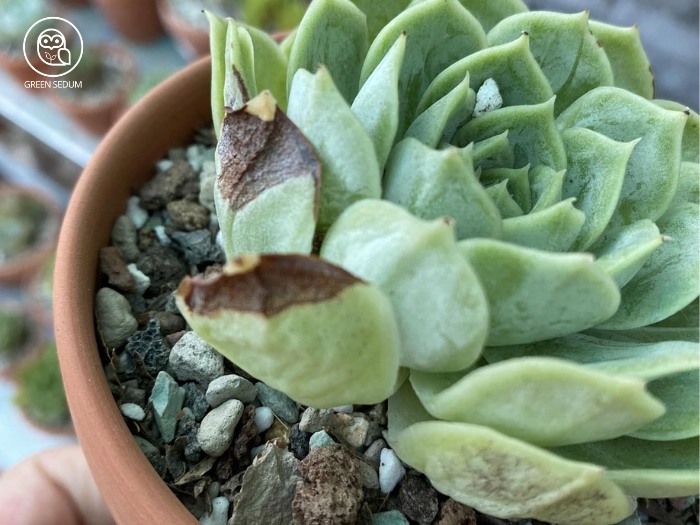
Identification:
Many succulent owners often confuse sunburn with leaf damage caused by pests, as the symptoms can appear similar. However, with sunburn, the leaves will wrinkle but remain plump and may even fall off. Conversely, sunburned leaves will shrink and darken, becoming more dry and blackened.
Causes:
This common issue often occurs during dry seasons when plants are exposed to full sunlight without adequate watering. Neglecting to water the plants due to an overly relaxed approach to care exacerbates the problem. Additionally, sudden weather changes, such as heavy rain followed by intense sunlight, can contribute to leaf sunburn. Placing newly planted succulents in direct sunlight after 10 a.m. (10 a.m. to 2 p.m.) can also lead to sunburn.
Remedies:
- Remove the damaged leaves, relocate the plant to a shaded area, and thoroughly water it to aid recovery. After about two weeks, gradually reintroduce the plant to sunlight.
- Alternatively, you can shield the succulents from intense sunlight by using garden netting or providing partial shade.
- During dry seasons, increase watering slightly to mitigate the effects of intense sunlight. The best time for sun exposure is before 10 a.m. for newly planted succulents.
4.4. Root Rot Disease
Symptoms:
You may notice that some lower leaves near the stem suddenly become soft, soggy, and darkened, with surrounding leaves gradually falling off.
Causes of Root Rot:
Root rot occurs when the planting medium is not clean and adequately aerated, impeding proper drainage. Alternatively, overwatering can saturate the soil, leading to poor drainage. This disease is most commonly observed during the rainy season.
Remedies and Proper Care:
To address root rot, it’s essential to replace the planting medium entirely and remove the old roots. Trim the base until you see no more dark, mushy areas and the inner portion appears clean and healthy. Then, allow the plant to dry in a well-ventilated area for 1-2 weeks until new roots emerge before replanting.
If the root system is heavily affected and cannot be salvaged, propagate the plant by removing healthy leaves for propagation.
>>> Check out related post: How to Propagate Succulents: Best Methods for Success
4.5. White Wax Scale Infestation
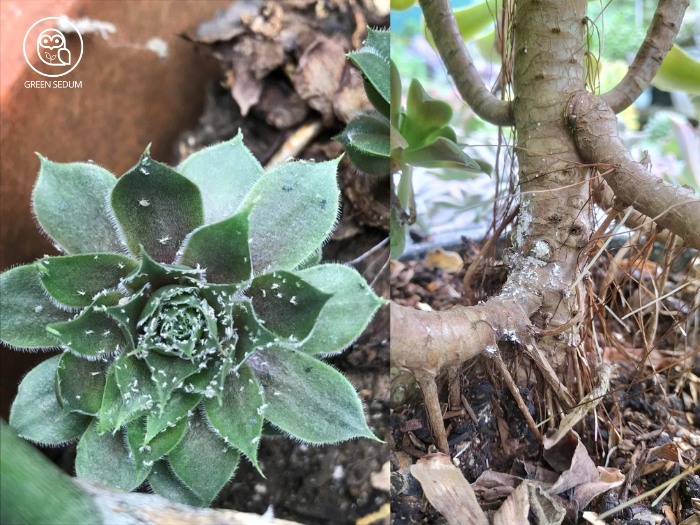
Common Symptoms:
Your plants may exhibit small, waxy white spots that move when touched. Infestations often spread rapidly to neighboring plants in the garden. Leaves may show signs of scale feeding, leaving behind raised scars that detract from the plant’s appearance or, in severe cases, cause leaf rot throughout the plant. Another sign is an increase in ant activity around the plant, as the scales excrete a sweet substance that attracts ants, who act as protectors of the scales. Nature truly has its own intriguing ways!
Causes:
Increased humidity in the plant’s environment or seasonal changes can make succulents susceptible to white wax scale infestations. Understanding how to care for succulents, especially in changing conditions, can help prevent such issues.
Remedies:
Immediately isolate infected plants to prevent further spread. Use tweezers to manually remove scales if the infestation is minimal. Apply a solution of diluted soapy water (3 drops of soap per liter of water), neem oil, or 70% rubbing alcohol directly to affected areas. Reapply every 2 days until the infestation is eradicated. Alternatively, using Thai purple powder can effectively eliminate scales. However, this method may generate heat and harm beneficial fungi, so it’s a last resort option.
4.6. Roots Growing from the Stem
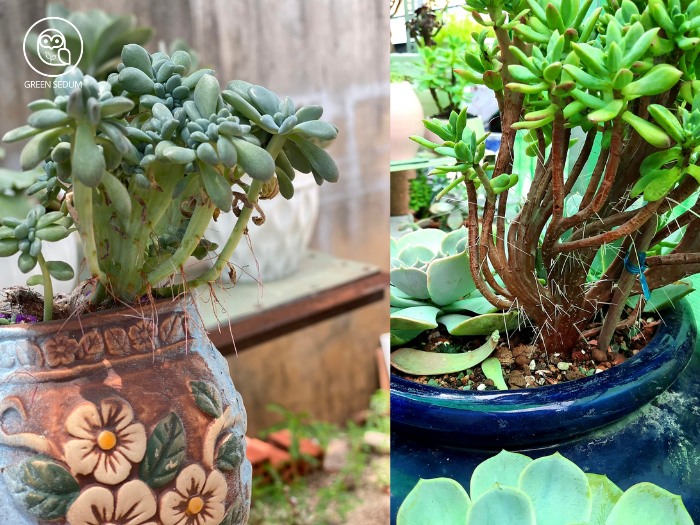
Symptoms and Causes:
- Case One: Roots growing out to maintain balance: In tall-stemmed succulents, roots may grow out to provide stability, as these plants are prone to tipping over. These roots aim to find support points to keep the plant upright.
- Case Two: No tipping, but roots growing from within the stem: This indicates a water deficiency within the plant and the substrate below lacks moisture. Consequently, roots grow on the stem to absorb moisture from the air to compensate for the lack of hydration.
Additionally, there are instances where leaves naturally break off and roots grow from them as a means of self-propagation. In such cases, simply allow the process to occur naturally.
Caring for Succulents with Stem Roots:
- For the first case, where roots grow for balance, consider repotting the plant into a new pot to prevent tipping or provide support for the plant to lean on to avoid falling over.
- In the second case, there’s no need to trim the roots. Instead, consider supplementing water for the succulent or replacing the substrate to ensure adequate moisture for the plant.
5. Conclusion
Truly, learning how to care for succulents is not as easy as we often read online or watch in social media clips. It’s only through understanding and hands-on practice that we realize its true complexity. Even with succulents I’ve nurtured for over a year, they still seem to languish as if in a perpetual slumber.
There were times when I felt disheartened, but I remembered the saying, “Every sorrow will pass, except the sorrow of sleep.” However, with determination to learn and care for succulents using entirely organic methods, I’ve found satisfaction in owning over 39 thriving pots, some of which have flourished for more than 2 years.
If you believe in cultivating succulents using this approach, congratulations on stepping out of your comfort zone. You’re sure to succeed with your choice! Remember to stay updated with Green Sedum’s succulent section for more insightful articles. Thank you for following along!
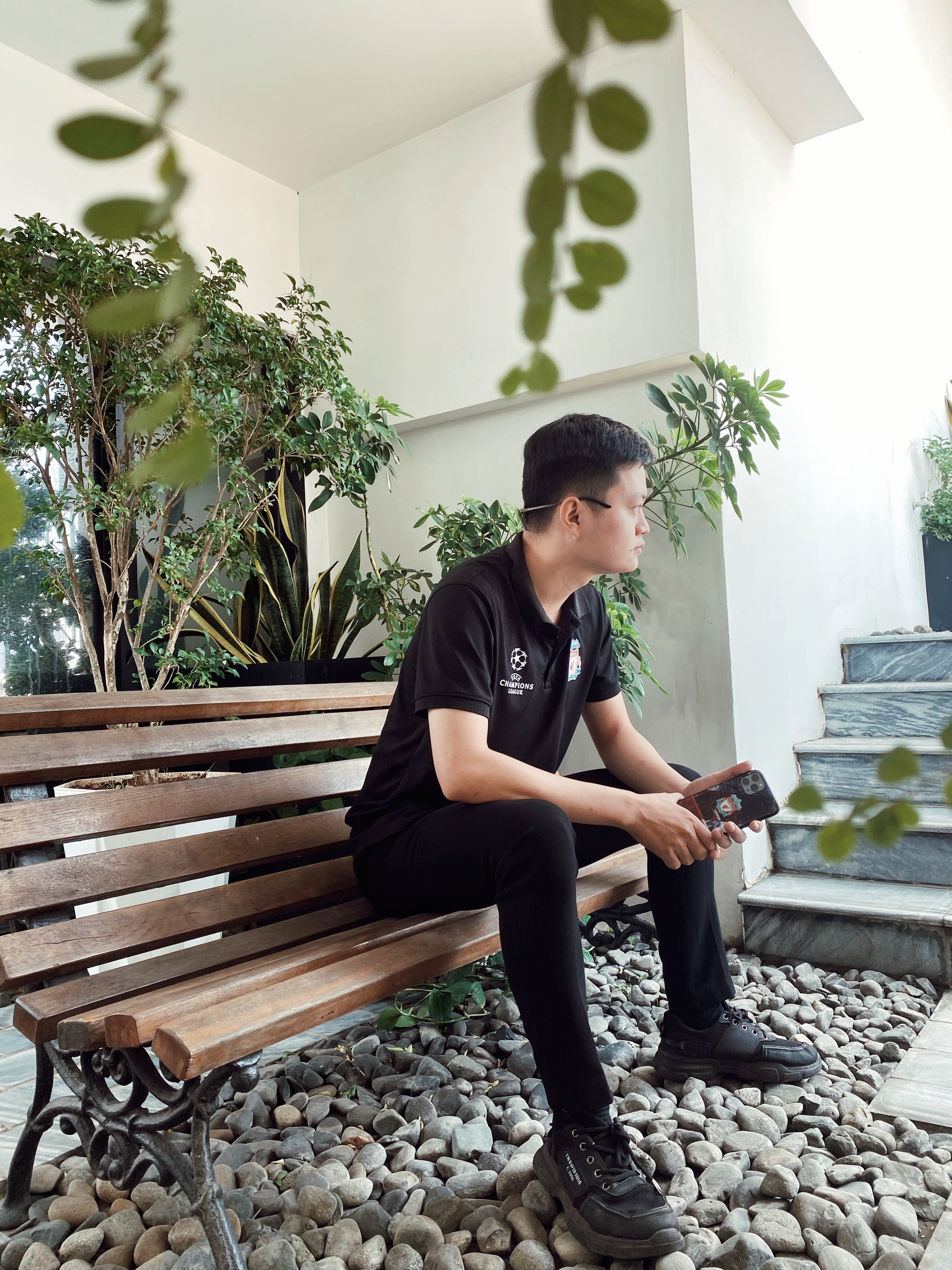
I’m Will Bernan, a gardening enthusiast with over 9 years of experience in succulents, indoor plants, and sustainable living. I also manage SEO for eco-friendly textile brands, promoting fabrics like bamboo and organic cotton.

